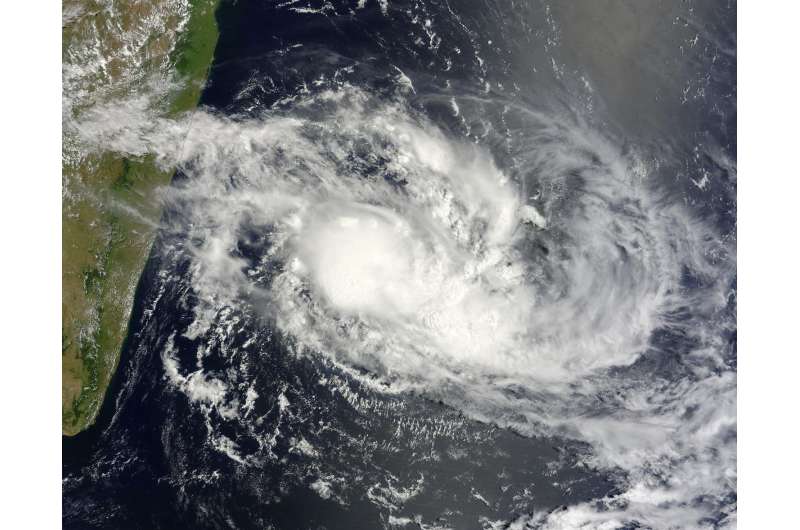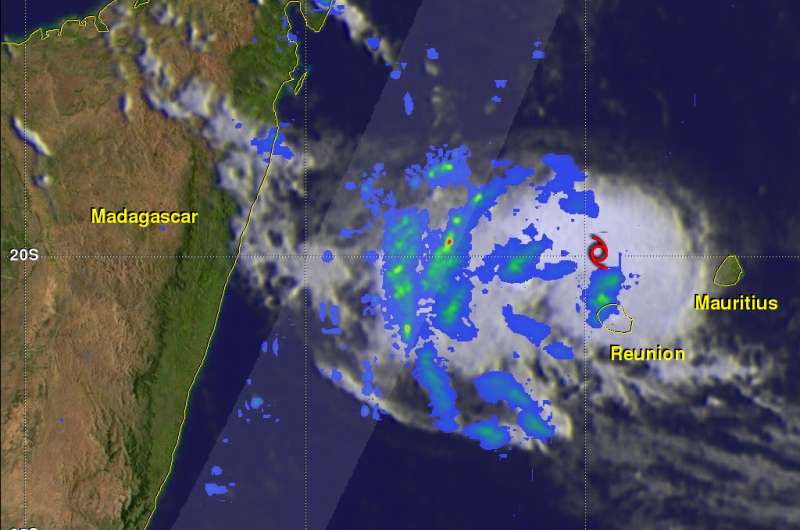On Feb. 8 at 06:45 UTC (1:45 a.m. EST) the MODIS instrument aboard NASA's Terra satellite captured this visible image of Tropical Cyclone Carlos off Madagascar's east coast. Credit: NASA Goddard MODIS Rapid Response Team
NASA found heavy rainfall occurring in Tropical Cyclone Carlos as it continued to move between Madagascar and La Reunion Island in the Southern Indian Ocean. NASA's Terra satellite imagery revealed a concentrated storm, while the GPM core satellite measured rainfall rates within the storm.
The Global Precipitation Measurement or GPM core observatory satellite flew above tropical cyclone Carlos on February 7, 2017 at 1056 UTC (5:56 a.m. EST). Carlos was moving past Reunion Island with maximum sustained winds estimated at 51.7 mph (45 knots/83.3 kph). GPM's Microwave Imager (GMI) and Dual-Frequency Precipitation Radar (DPR) data show that rain bands west of Carlos' center were producing heavy rainfall. DPR measured a few downpours in the bands west of the Carlos' center of circulation dropping rain at a rate of over 120 mm (4.7 inches) per hour. GPM's radar (DPR Ku Band) found that a few storm tops were reaching heights of 11 km (8.8 miles). GPM is a joint mission between NASA and the Japanese space agency JAXA.
On Feb. 8 at 1500 UTC (10 a.m. EST) Tropical Storm Carlos' maximum sustained winds were near 51.7 mph (45 knots/83.3 kph). The Joint Typhoon Warning Center expects Carlos to strengthen to 69 mph (60 knots/111 kph) by Feb. 10. Carlos was centered near 22.8 degrees south latitude and 52.5 degrees east longitude, about 197 nautical miles southwest of St. Denis, La Reunion Island. Carlos was moving to the southwest at 6.9 mph (6 knots/11.1 kph).
The GPM core observatory satellite flew above tropical cyclone Carlos on Feb. 7, 2017, at 1056 UTC and measured a few downpours in the bands west of the Carlos' center of circulation dropping rain at a rate of over 120 mm (4.7 inches) per hour. A few storm tops were reaching heights of 11 km (8.8 miles). Credit: NASA/JAXA, Hal Pierce
On Feb. 8 at 06:45 UTC (1:45 a.m. EST) the Moderate Resolution Imaging Spectroradiometer or MODIS instrument aboard NASA's Terra satellite captured a visible image of Tropical Cyclone Carlos off Madagascar's east coast. The image showed strong thunderstorms over a compact low-level circulation center.
Over the next two days tropical cyclone Carlos is predicted to follow a track between southern Madagascar and La Reunion. Then Carlos is predicted to re-curve toward the southeast. Vertical wind shear is expected to decrease during the next couple days so Carlos may intensify for a while. After a couple of days vertical wind shear and cooler sea surface temperatures are expected to cause Carlos to gradually weaken.
The GPM core observatory satellite flew above tropical cyclone Carlos on Feb. 7, 2017, at 1056 UTC and measured a few downpours in the bands west of the Carlos' center of circulation dropping rain at a rate of over 120 mm (4.7 inches) per hour. A few storm tops were reaching heights of 11 km (8.8 miles). Credit: NASA/JAXA, Hal Pierce
Provided by NASA's Goddard Space Flight Center

























